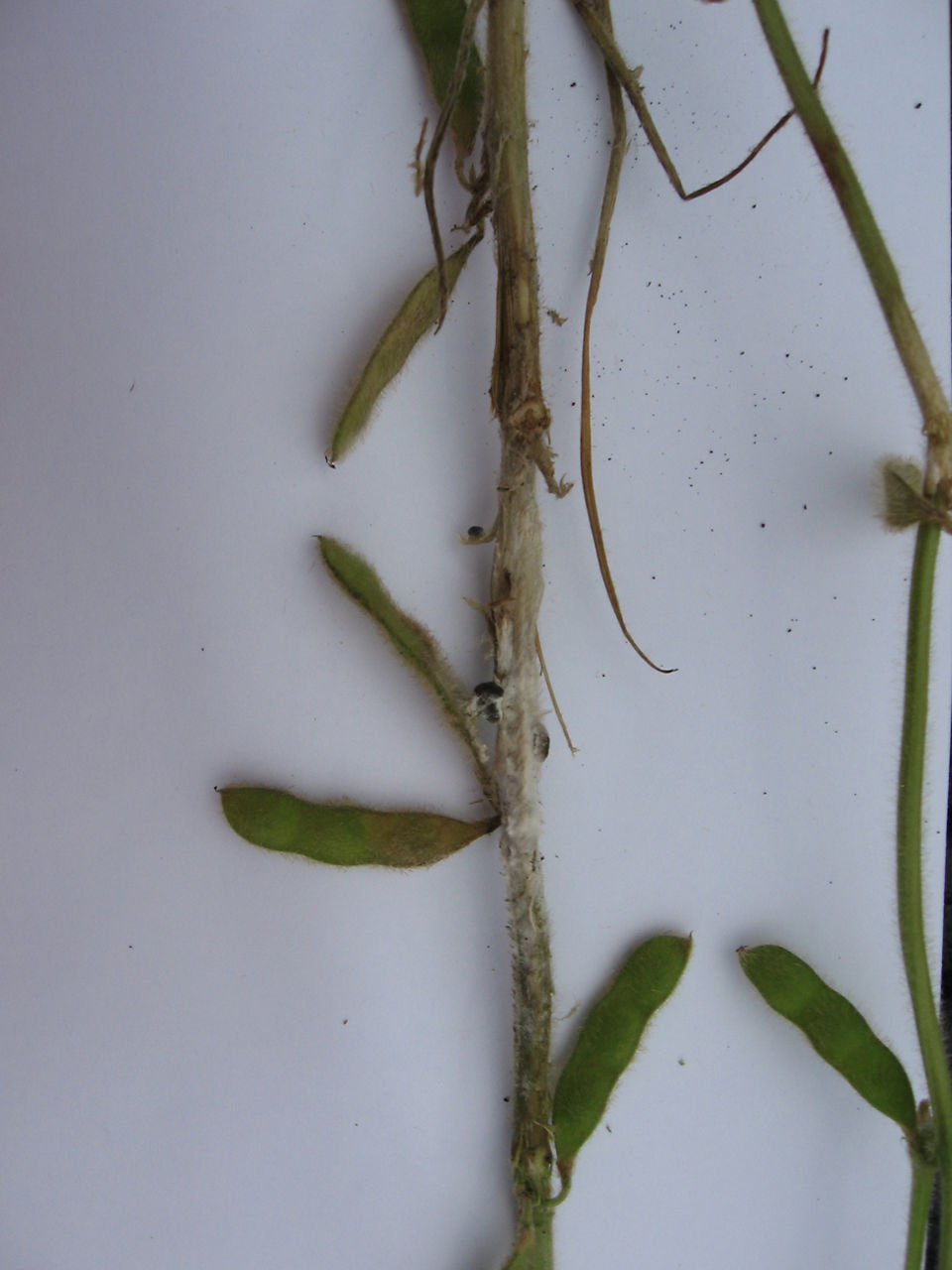5 MIN READ
Mid-Season White Mold Management
July 25, 2023
Disease Impact
White mold, or Sclerotinia stem rot, is a soybean disease caused by the fungus Sclerotinia sclerotiorum that can cause considerable economic yield loss. In 2017, the yield loss across the United States was estimated at 57.4 million bushels.1 An estimated two to five bu/acre yield reduction may occur for every 10% increase in disease incidence.2
Symptoms and Identification
Initial symptoms appear as a bleaching of the stems (Figure 1). You must look under the canopy to identify this symptom. As the disease progresses, you will see the characteristic production of white, fluffy, cottony mycelial growth on the outer stem layer and pods (Figure 1). This is also accompanied by wilting of the leaves, which develop a grayish-green cast (Figure 2), and plant death. Small, black, and hard structures (sclerotia) that resemble mouse or rat droppings can be found inside and/or outside infected tissues (Figure 3).



Disease Cycle
As with all crop diseases, the disease triangle is in play with white mold. The pathogen must be present to infect a susceptible host and the growing conditions must be favorable to sustain the pathogen’s development.3 The timing of these three components is also key since flowers—which are present from R1 to R3—are the primary tissue for infection. In infested fields, the hard sclerotia overwinter and germinate in the spring to form fruiting bodies (apothecia or mushrooms), which begin releasing spores when mature (Figure 4). The spores are forcibly ejected from the apothecia and land on flowers or other tissues, such as senesced lower stems. When wet, cool (53.6 to 75.2 °F) growing conditions are present within and below the canopy, spores can infect and initiate disease development. There are other fungal species that produce mushrooms that can be confused with white mold apothecia, especially birds nest fungus, which is a harmless organism that helps break down stubble and other organic residue.4

Management Considerations
After infection occurs, little can be done to alleviate potential yield loss. When considering the disease triangle, high tolerance or resistance among soybean products is limited and environmental management is not possible except for managing irrigation, which may have to be reduced.
No-till leaves sclerotia on the soil surface where they can germinate; however, sclerotia numbers generally decrease over time when on the soil surface. Since the sclerotia can survive being buried with tillage, subsequent tillage can bring the sclerotia to the surface where they can germinate.5
In areas with a high prevalence of white mold, especially Iowa, Wisconsin, Minnesota, northern Illinois and Indiana, Ohio, and Michigan, the planting of other white mold-susceptible crops should be avoided. Short intervals between rotations such as a corn-soybean rotation should also be avoided because the long-lived sclerotia can continue to increase in the soil.5 Many weeds are susceptible to white mold; therefore, weed growth should be managed appropriately.
Other management factors that can be controlled include selecting soybean products with higher tolerance, reducing seeding rate, and employing an appropriate soybean row width.5 Soybean products vary on tolerance to white mold; therefore, careful review of seed guides can help determine products that have higher tolerance ratings. An early canopy closure helps keep the soil moist, which is favorable for white mold development. Therefore, creating an environment where canopy closure is delayed by decreasing seeding rates and using wide rows can help reduce the potential for white mold development.
Manure and nitrogen applications should be avoided on soybean fields with a history of white mold. These practices can increase early plant growth, resulting in quicker canopy closer, which is favorable for white mold development.
A timely fungicide application of a product labeled for white mold can help prevent white mold. Since white mold infects through the flowers, it is imperative the application is applied during flowering. Applications should be made at the beginning of flowering (R1 growth stage) with a possible follow-up application a week or two later, up to the beginning of pod development (R3 growth stage). To be successful, the fungicide should have good penetration deep into the canopy.4
The Sporecaster smartphone app designed by the University of Wisconsin is available to help predict the need and timing for a fungicide application to control white mold. The app uses university research to help forecast the risk of white mold apothecia being present in a soybean field. The information can be used to target fungicide application timing and soybean flowering. It is available through both Android and Apple platforms.6
Delaro® 325 SC Fungicide (two modes of action) and Delaro® Complete Fungicide (three modes of action) offer broad-spectrum disease control in soybean, including suppression of white mold. Either product should be applied prior to disease development at the R1 growth stage with a second application at the R3 growth stage as needed. For specific rate and application timing information, please visit https://www.cropscience.bayer.us/products/fungicides and contact your retailer. Always read and follow product label instructions and restrictions.
In summary, implementing some of the above practices can help reduce the effect of white mold during the growing season while helping to maximize soybean yield potential.
Sources:
1Bradley, C., Allen, T., Tenuta, A., Mehl, K., and Sisson, A. Soybean disease loss estimates from the United States and Ontario, Canada-2017. Soybean Disease Management. CPN-1018-17-W. Crop Protection Network. https://crop-protection-network.s3.amazonaws.com/publications/disease-loss-estimates-2017-filename-2019-07-26-165710.pdf.
2Byamukama, E., Tande, C., and Mathew, F. 2020. White mold (Sclerotinia stem rot) of soybean. SDSU Extension. South Dakota State University. https://extension.sdstate.edu/sites/default/files/2020-08/P-00181.pdf.
3Staton, M. and Chilvers, M. 2021. Begin managing white mold in soybeans this spring. MSU Extension. Michigan State University. https://www.canr.msu.edu/news/begin_managing_white_mold_in_soybeans_this_spring
4Chilvers, M. 2015. White mold of soybeans and foliar fungicides. MSU Extension. Michigan State University. https://www.canr.msu.edu/news/white_mold_of_soybeans_and_foliar_fungicides_1
5Mueller, D. White mold. Integrated Crop Management. Iowa State University Extension and Outreach. https://crops.extension.iastate.edu/encyclopedia/white-mold/.
6Smith, D., Schmidt, R. and Conley, S. 2018. New smarthphone app: Sporecaster, the white mold forecaster. Integrated Pest and Crop Management. University of Wisconsin-Madison. https://ipcm.wisc.edu/blog/2018/05/new-smartphone-app-sporecaster-the-soybean-white-mold-forecaster/.
1311_143920
You may also like...
Here are some articles that may also be of interest to you